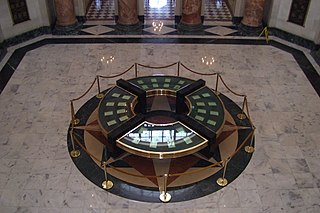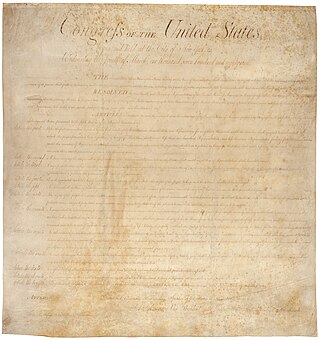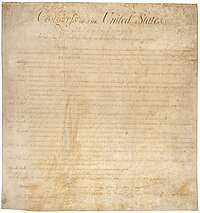
The First Amendment to the United States Constitution prevents the government from making laws that: regulate an establishment of religion; prohibit the free exercise of religion; abridge the freedom of speech, the freedom of the press, the freedom of assembly, or the right to petition the government for redress of grievances. It was adopted on December 15, 1791, as one of the ten amendments that constitute the Bill of Rights.

The Bill of Rights 1689 is an Act of the Parliament of England that set out certain basic civil rights and clarified who would be next to inherit the Crown. It remains a crucial statute in English constitutional law.
The Slaughter-House Cases, 83 U.S. 36 (1873), was a landmark U.S. Supreme Court decision consolidating several cases that held that the Privileges or Immunities Clause of the Fourteenth Amendment to the U.S. Constitution only protects the legal rights that are associated with federal U.S. citizenship, not those that pertain to state citizenship. Though the decision in the Slaughter-House Cases minimized the impact of the Privileges or Immunities Clause on state law, the Supreme Court would later incorporate the Bill of Rights to strike down state laws on the basis of other clauses. In 2010, the Court rejected arguments in McDonald v. Chicago to overrule the established precedent of Slaughterhouse and decided instead to incorporate the Second Amendment via the Due Process Clause of the Fourteenth Amendment.
Freedom of association encompasses both an individual's right to join or leave groups voluntarily, the right of the group to take collective action to pursue the interests of its members, and the right of an association to accept or decline membership based on certain criteria. It can be described as the right of a person coming together with other individuals to collectively express, promote, pursue and/or defend common interests. Freedom of association is both an individual right and a collective right, guaranteed by all modern and democratic legal systems, including the United States Bill of Rights, article 11 of the European Convention on Human Rights, section 2 of the Canadian Charter of Rights and Freedoms, and international law, including articles 20 and 23 of the Universal Declaration of Human Rights and article 22 of International Covenant on Civil and Political Rights. The Declaration on Fundamental Principles and Rights at Work by the International Labour Organization also ensures these rights.

The Constitution of the Commonwealth of Puerto Rico is the controlling government document of Puerto Rico. It is composed of nine articles detailing the structure of the government as well as the function of several of its institutions. The document also contains an extensive and specific bill of rights. It was ratified by Puerto Rico's electorate in a referendum on March 3, 1952, and on July 25, 1952, Governor Luis Muñoz Marín proclaimed that the constitution was in effect. July 25 is known as Constitution Day.

The Constitution of the State of Hawaii, also known as the Hawaii State Constitution, is the fundamental governing document of the U.S. state of Hawaiʻi. As an organic text, it establishes the principles and framework of government, enumerates the rights and freedoms of Hawaiian citizens, and serves as the supreme law of the state.
McGowan v. Maryland, 366 U.S. 420 (1961), was a United States Supreme Court case that upheld Sunday closing laws, in which the court held that laws with religious origins are not unconstitutional if they have a secular purpose.
In United States constitutional law, incorporation is the doctrine by which portions of the Bill of Rights have been made applicable to the states. When the Bill of Rights was ratified, the courts held that its protections extended only to the actions of the federal government and that the Bill of Rights did not place limitations on the authority of the state and local governments. However, the post–Civil War era, beginning in 1865 with the Thirteenth Amendment, which declared the abolition of slavery, gave rise to the incorporation of other amendments, applying more rights to the states and people over time. Gradually, various portions of the Bill of Rights have been held to be applicable to state and local governments by incorporation via the Due Process Clause of the Fourteenth Amendment of 1868.
In United States law, the Establishment Clause of the First Amendment to the United States Constitution, together with that Amendment's Free Exercise Clause, form the constitutional right of freedom of religion. The relevant constitutional text is:
Congress shall make no law respecting an establishment of religion...

The Claim of Right is an Act passed by the Convention of the Estates, a sister body to the Parliament of Scotland, in April 1689. It is one of the key documents of United Kingdom constitutional law and Scottish constitutional law.
Edwards v. South Carolina, 372 U.S. 229 (1963), was a landmark decision of the US Supreme Court ruling that the First and Fourteenth Amendments to the U.S. Constitution forbade state government officials to force a crowd to disperse when they are otherwise legally marching in front of a state house.

The Declaration of Right, or Declaration of Rights, is a document produced by the English Parliament, following the 1688 Glorious Revolution. It sets out the wrongs committed by the exiled James II, the rights of English citizens, and the obligation of their monarch.
The right to petition government for redress of grievances is the right to make a complaint to, or seek the assistance of, one's government, without fear of punishment or reprisals.

The United States Bill of Rights comprises the first ten amendments to the United States Constitution. Proposed following the often bitter 1787–88 debate over the ratification of the Constitution and written to address the objections raised by Anti-Federalists, the Bill of Rights amendments add to the Constitution specific guarantees of personal freedoms and rights, clear limitations on the government's power in judicial and other proceedings, and explicit declarations that all powers not specifically granted to the federal government by the Constitution are reserved to the states or the people. The concepts codified in these amendments are built upon those in earlier documents, especially the Virginia Declaration of Rights (1776), as well as the Northwest Ordinance (1787), the English Bill of Rights (1689), and Magna Carta (1215).
Presser v. Illinois, 116 U.S. 252 (1886), was a landmark decision of the Supreme Court of the United States that held, "Unless restrained by their own constitutions, state legislatures may enact statutes to control and regulate all organizations, drilling, and parading of military bodies and associations except those which are authorized by the militia laws of the United States." It states that the Second Amendment to the United States Constitution limited only the power of Congress and the national government to control firearms, not that of the states, and that the right to peaceably assemble in the First Amendment to the United States Constitution was not protected by the clause referred to except to petition the government for a redress of grievances. This decision was overruled in McDonald v. City of Chicago in (2010).
Pruneyard Shopping Center v. Robins, 447 U.S. 74 (1980), was a U.S. Supreme Court decision issued on June 9, 1980 which affirmed the decision of the California Supreme Court in a case that arose out of a free speech dispute between the Pruneyard Shopping Center in Campbell, California, and several local high school students.
Ex parte Curtis, 106 U.S. 371 (1882), is an 8–1 ruling by the United States Supreme Court that the Act of August 15, 1876 was a constitutional exercise of the enumerated powers of the United States Congress under Article I, Section 8 of the United States Constitution.
Borough of Duryea v. Guarnieri, 564 U.S. 379 (2011), was a case in which the Supreme Court of the United States held the public concern test limits Petition Clause claims by public employees. More specifically, state and local government employees may not sue their employers for retaliation under the Petition Clause of the First Amendment when they petition the government on matters of private concern. To show that an employer interfered with rights under the Free Speech Clause of the First Amendment, an employee must show that his speech related to a matter of public concern. The court held that this test also applies when the employee invokes the Petition Clause. The case is significant under the Petition Clause because 1.) it recognized that lawsuits are “Petitions” under the First Amendment and 2.) it explains that the Petition Clause and Speech Clause are not always coextensive, and leaves open the possibility that here may be additional claims under the Petition Clause which plaintiffs may invoke consistent with the purpose of that Clause.
Heffernan v. City of Paterson, 578 U.S. ___ (2016), was a United States Supreme Court case in 2016 concerning the First Amendment rights of public employees. By a 6–2 margin, the Court held that a public employee's constitutional rights might be violated when an employer, believing that the employee was engaging in what would be protected speech, disciplines them because of that belief, even if the employee did not exercise such a constitutional right.
California Motor Transport Co. v. Trucking Unlimited, 404 U.S. 508 (1972), was a landmark decision of the US Supreme Court involving the right to make petitions to the government. The right to petition is enshrined in the First Amendment to the United States Constitution as: "Congress shall make no law...abridging...the right of the people...to petition the Government for a redress of grievances." This case involved an accusation that one group of companies was using state and federal regulatory actions to eliminate competitors. The Supreme Court ruled that the right to petition is integral to the legal system but using lawful means to achieve unlawful restraint of trade is not protected.








